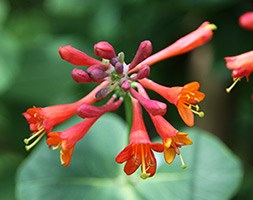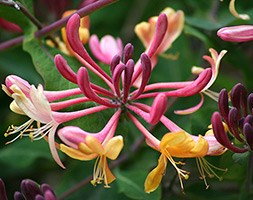New products at Crocus
by Sarah - June 9th, 2014.Filed under: Crocus, New Products.
New lines today at Crocus
Lonicera x brownii ‘Dropmore Scarlet’ (scarlet trumpet honeysuckle) £3.99
Position: full sun or partial shade Soil: fertile, humus-rich, moist, well-drained soil Rate of growth: average Flowering period: July to September Hardiness: fully hardy This honeysuckle has a real wow factor, with long, trumpet-shaped, vivid scarlet flowers from July to September, followed in hot summers by small red berries. Although it is unscented (or with just a faint hint of perfume), the flower colour more than makes up for the lack of fragrance, and its handsome, semi-evergreen (or deciduous in colder winters) blue-green leaves provide valuable cover for a pergola or boundary wall. An unusual climber for a cottage-style garden. Garden care: Cut back established plants after flowering, removing a third of the flowering shoots. Apply a generous 5-7cm (2-3in) mulch of well-rotted compost or manure around the base of the plant in early spring.
Lonicera x heckrottii ‘Gold Flame’ (honeysuckle (syn American Beauty)) £3.99
Position: full sun or partial shade Soil: fertile, humus-rich, moist, well-drained soil Rate of growth: fast-growing Flowering period: June to August Hardiness: fully hardy Fabulously fragrant, pink-flushed, orange-yellow, tubular flowers from June to August, followed by red berries in hot summers. This vigorous, shrubby honeysuckle is semi-evergreen in milder winters, and looks lovely in a small cottage-style or wildlife garden. Since it doesn’t have the twining branches found on other varieties, it will need to be tied with garden twine to an upright support. Garden care: Cut back established plants after flowering, removing a third of the flowering shoots. Apply a generous 5-7cm (2-3in) mulch of well-rotted compost or manure around the base of the plant in early spring.








